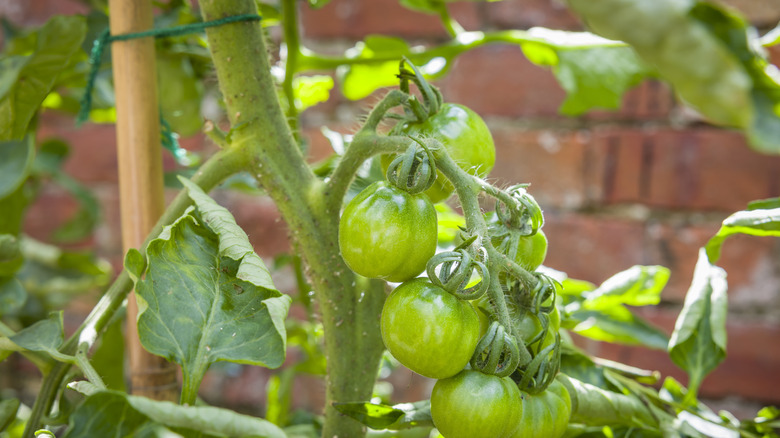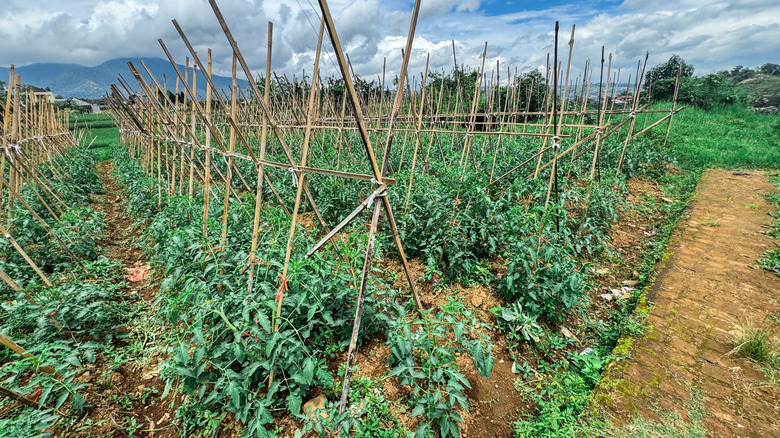Martha Stewart Shares Her Tip For Stronger, Healthier Tomato Plants
When not busy in the kitchen preparing meals or organizing her clever pots and pans storage, Martha Stewart enjoys spending time in her gardens — the lifestyle guru owns several properties, and a staple feature among them is a lush garden or farm. If you are thinking of growing tomatoes in your backyard, she's the best person to ask for guidance. On more than one occasion, Stewart has featured her healthy and flourishing tomato plants on her social media, and it's evident that she really knows a thing or two about growing them based on her harvests. Her secret? Giving them the best structural support they can have using bamboo stakes.
"If you've ever grown a vining plant, you know how important it is to provide strong structures to which the vines can cling and climb," Stewart wrote on her blog, revealing that she employs a custom bamboo staking system to keep her tomato plants upright and prevent the fruits from sagging and touching the ground. Of course, one might argue that staking tomatoes is common practice. It's one of the basic tips for growing tomatoes in the garden. In the television personality's case, however, she elevates this hack by setting up the bamboo stakes in a way that resembles a row of tents. She leans the poles together and then ties them with jute twine. She also makes modifications as the plants grow. "I stake my tomatoes in stages, using taller, stronger supports as the plants develop," she wrote.
Why Martha Stewart uses bamboo to stake her tomatoes
Of all the materials available for staking, Martha Stewart favors bamboo, and it's easy to see why. Bamboo is sustainable, sturdy, and stylish — three qualities that align with her home and gardening philosophy. "At my Bedford, New York farm, I use bamboo to build the teepees that support my growing tomato plants," she noted in another blog post. "Bamboo is attractive, easy to find, and can be reused year after year."
Beyond its aesthetic appeal, bamboo offers noteworthy benefits to a garden. For instance, it is pest-resistant. It is one of those plants that can thrive on their own without the need for pesticides and chemical fertilizers. Speaking of thriving, bamboo can grow in many different environments, especially in regions with tropical, subtropical, or temperate climates. You need to be careful about growing your own, however, since planting bamboo near your home can cause serious damage due to some species' highly aggressive nature.
For Stewart, she prefers bamboo stakes for her tomato plants for two main reasons: they don't require chemical treatments, and they are relatively inexpensive. "Never use chemically treated wood or other material for staking climbers, as the chemicals would likely run off and go into the soil," she explained before suggesting that anyone who wishes to use her method should consider buying bamboo canes in bulk. Unlike traditional tomato cages or bulky wooden trellises, Stewart's minimalist design requires just one tall stake per plant and a few crossbars for bracing.
How to build Stewart's tomato support system in your backyard
Tomatoes are not the best choice for beginner gardeners, but if you really want to grow them in your backyard, you need to carefully plan things out to replicate Stewart's gardening hack with ease and reap the same benefits as she does. After planting two parallel rows of tomatoes in your garden, prepare the following: one 10-foot bamboo pole for each plant, shorter bamboo cuts to support the poles, and jute twine for tying them together.
Place one bamboo pole between each row of tomato plants. Angle the poles toward each other so their top ends meet. Tie them together using jute twine to form a triangular arch. Repeat this for all rows until you form a series of tent-like structures. Next, use the shorter bamboo sticks to strengthen the structure. Tie them horizontally between the standing poles at about 2 feet above the ground. This way, they can stabilize the structure and help the tomato plants grow along the bamboo stakes.
As the tomato starts growing, tie each plant to the main bamboo pole using figure-eight knots. Add more horizontal support to the structure as needed, so the teepee remains sturdy. This will allow the tomato plants to grow tall without the risk of the stems breaking under the weight of the fruits. Finally, don't throw the bamboo stakes away after a harvest. Store them dry and reuse them the next time you grow a new batch of tomatoes.


